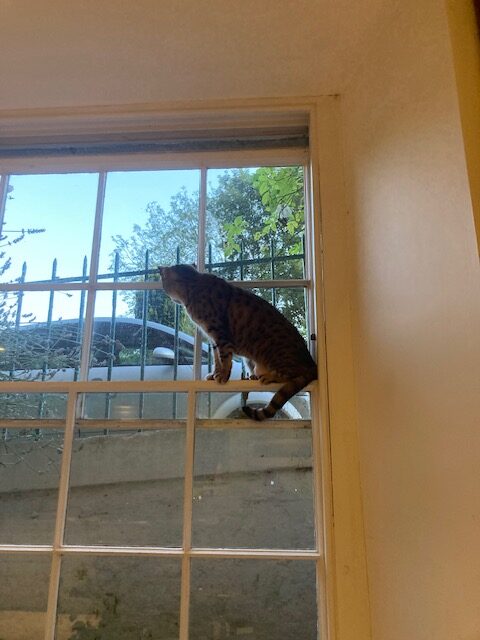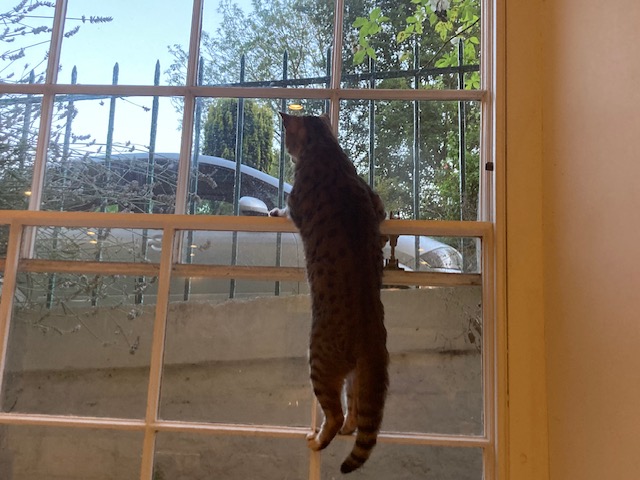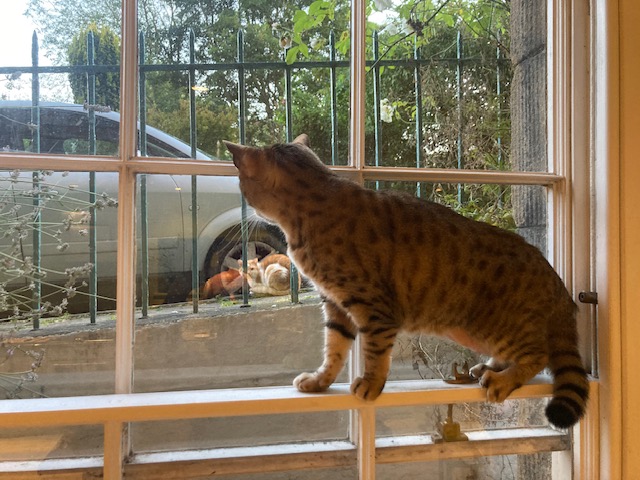All summer long, our little cat Phoebe spent much of her time squeezed onto the kitchen window bar, gazing out into the garden. How sweet, I thought, she is looking out on the sunshine and flowers. Coming home and encountering her yet again in position, we would say ‘she must really like sitting there’.

Weeks went by and it began to unsettle me. This is starting to seem obsessive; she has become like Edward in Harold Pinter’s A Slight Ache, staring up the lane from the scullery to see if the silent match-seller is in sight. Finding her unresponsive, curled up in her bed when I came down to make the morning tea gradually went from being charming to worrying. Has she worn herself out with her vigil? What if looking out all day and night is actually a horrific and exhausting chore? What if it is making her ill? Eventually, in an insomniac moment, I could not stop myself descending at 3am, to discover the silhouette of Phoebe by moonlight, at her post, peering fixedly into the gloom.
We took her to the country for a couple of weeks. My anguish heightened a notch when, on returning and being released from her cat carrier, she sprinted downstairs to her post, where the window now had a greasy streak from her pressed nose, and stuck there.

A little later, the evidence became incontrovertible. Two huge tom cats were having a territory war in the street outside; one or other would patrol past every day or two. It was appalling for her to spy one, brazenly milling outside (female cats outside oestrus – and Phoebe is neutered – have no interest in sex; but they are worried about competition and violence). She would fill the kitchen with low moans, her tail bushed, almost foaming at the lips in her terror, but could not pull her gaze away. It took her many minutes to calm down. Phoebe didn’t like looking out from her post; she could not help it. The garden was not a scene of beauty; it was a site of mesmerising threat.

Phoebe and her problems remind me of David Hume’s essay Of tragedy. Why do people pay attention to representations – tragedies, horror movies, dark paintings – whose emotional effects include, prominently, negative emotions such as fear, anxiety and disgust? As you can imagine there is a substantial literature on this problem (see here for example). All of the many offered solutions seem to me special pleading or failures to really resolve it. We admire the beauty of the construction (Hume’s answer). We enjoy the moral evaluation that our own negative feelings are justified, or enjoy seeing the baddie get their comeuppance. Or, negative emotions produce arousal and we like arousal (even if negative in source) when we have nothing much else to do. Or, the negative emotions in question are not really negative but counter-evidentially positive, maybe because you have distance from or control over them, or because you frame them a certain way. And so on. But the point is, Phoebe spent her summer on the window bar without seeing any baddies get their comeuppance; without admiring any artistry; without being paradoxically ennobled; without having any detachment or control; certainly without moral vindication. Yet, there she was.
Whether the paradox of tragedy is even a paradox rather depends on your underlying model of how minds work. Intuitively, humans adopt the naïve utility calculus as their working model of the mind. That is, we assume that people (or cats) do actions because they like them; their liking is what makes them do the actions. Hence, the paradox: if they are doing things that seem to make them feel awful, those things must not really make them feel awful (or they wouldn’t be doing them); there must be some convoluted way in which they actually like those things, all evidence to the contrary. Thence all the various epicycles to explain how this could be the case, to square the evidence of our senses with the obvious violation of the naïve utility principle.
But the naïve utility calculus is an everyday working model – a folk theory – not a good scientific account of how minds actually work. Minds are bundles of evolved mechanisms, mechanisms that generate attention and motivation to certain categories of things: conspecific and allospecific threats, potential food, potential allies, potential shelter, and so on. We don’t attend to those things for some higher-order reason such as we like them, or we estimate that we will have greater hedonic utility if we attend to them. We attend to them because they capture our attention, given the design of the mental mechanisms we have. As John Tooby and Leda Cosmides argued, humans are best conceived of as adaptation executors, not maximizers of fitness, utility, or pleasure. A fortiori they would apply this to cats too. From this point of view, there is no paradox whatever about Phoebe allocating all her time to a vigil that made her feel dreadful. Her mind was telling her she needed to keep an eye on that stuff, like it or not. Even in humans, it’s really, really difficult to switch off mechanisms when they are doing their thing, even though we have enough self-reflection to understand sometimes that we are self-harming in the process. Think of behavioural addictions, or devastating unrequited love.
How does this help with the paradox of tragedy in art? For one thing it shows that if you base your philosophy and psychology on a folk theory of the mind, you will generate apparent scientific puzzles that have no solution (other than: don’t start from there!). As my colleagues Edgar Dubourg and Nicolas Baumard have argued, artistic representations are cultural technologies. They are deliberately made by producers in order to capture the attention of consumers, just like you would make a shoe to protect a foot. Those producers understand something about the minds of audiences, like cobblers understand something about the anatomy of feet. So, naturally, the producers include ingredients that are good at causing mental adaptations in the audience to allocate attention: they include predators and rivals, love objects and moral regularities, places of shelter and places to flee, and so on. (There is a TEDX talk in French by Edgar on his work here.)
Producers typically include a range of different ones of these ingredients, to keep up the interest and lessen habituation. Thus, there is a very large set of different possible genres and sub-genres with different mixes of ingredients. But there is no requirement that artistic representations have to be positive in some general affective sense; they just have to succeed at making other minds pay attention. For humans, they have other requirements too, in order to endure. They have to hang together in some kind of plausible way, and the most durable ones have to repay cognitive reflection and communication. Artistic representations can be co-opted for other purposes such as teaching or there creation of coalitions. But those things are not their functions, and, to the point, there is no particular paradox if they incite mainly negative emotion rather than mainly positive emotion.
Ludwig Wittgenstein wrote that if a lion could speak, we would not be able to understand it. I think the point is that what is relevant and attention-grabbing to a creature depends what kind of mind that creature has; and that in turn depends, in Wittgenstein’s words, on the creature’s ‘form of life’. In more contemporary parlance, we would call this the ecology within which the creature’s mental mechanisms have evolved and developed. An unmoving tom cat sitting on the pavement is not my idea of an attention-grabbing spectacle (though come to think of it, isn’t there a late Samuel Beckett play that is more or less that?). Who knows how captivating, how nuanced, how dreadful, it was to Phoebe? If cats made art, maybe that is the art they would make.
October update: Autumn has come, the tom cats have gone, and Phoebe has left her position on the window bar.
Discover more from Daniel Nettle
Subscribe to get the latest posts sent to your email.